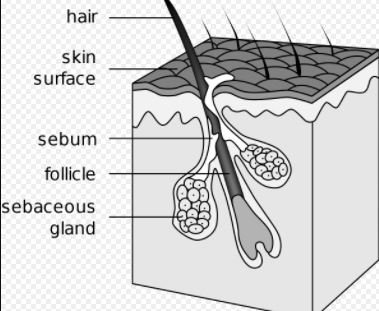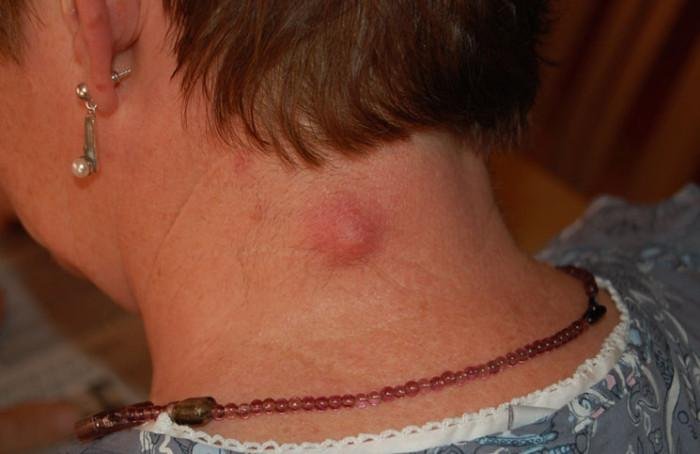What are Sebaceous Glands?
Sebaceous glands are glands that produce oil in your body. They produce sebum which consists of fatty substance and cell debris.
Apart from your palms and soles, sebaceous glands are found throughout the skin of your body. Generally sebaceous glands are situated in parts of your body that have hair.

The gland can also be located in areas without hair on your body such as nose, eyes, nipples, penis and labia minora.
On the penis, the gland is yellowish in color and small in size. The small size of the gland is due to the thin penis tissues. In some people, the sebaceous gland of the penis is more visible than others.
People may consider this as unusual condition and try to eliminate the gland by punching it. This may cause swelling on your penis but can be treated with antibiotics.
Functions
Sebaceous glands perform crucial function in your body. These functions include:
- The main function of the sebaceous glands is to protect your skin. These glands produce sebum, an oily substance that oils your hair and skin.
- The gland stops too much evaporation of water from your skin hence moisturizing the skin. It also moisturizes your hair preventing it from breaking and becoming dry.
- Another function is the sebum protects your skin against bacterial infections. The sebum consists of chemicals such as squalene, triglycerides, wax monoesters that destroy bacteria on your skin.
Hyperactive Sebaceous glands
In some cases, your sebaceous glands may become overactive and secrete excess sebum in your body. This may be attributed to age; hyperactive gland is more prevalent in young people of age 12-20 years.
Excess sebum in your body may lead to serious skin conditions. These skin conditions are as follows:
Acne

Acne is a skin condition that occurs during puberty. Normally your skin has tiny holes, which are joined to the oil gland below the skin and the gland is connected to these holes through the follicles.
Sebum is responsible for carrying dead cells out of the skin through the follicles. When sebum is secreted in excess it accumulates under your skin and obstructs the follicles. This causes acne. Acne affects people of ages but is more prevalent in adolescents and young adults. There are many types of acne such as:
Cysts
They are easily noticed on your skin and filled with pus and are painful
Nobules
They are large, solid and painful pimples found deep in your skin
Papules
They are small bumps and pink in color on your skin
Blackheads
Blackheads are black in color and are found on the surface of your skin
Whiteheads
whiteheads are very small and found under your skin.
Treatment of acne
Treating acne depends on its severity. For mild acne, you can get over-the-counter medication with or without your doctor’s prescription. These medicines may be in form of cream, lotions, gel and soap.
Depending on the nature of your skin, you can apply the one that is appropriate. For people with oily skin, use gels while those with a sensitive skin apply cream or lotion.
People with severe acne must see a dermatologist, an expert in skin treatment. Your dermatologist will diagnose the condition and may prescribe the following medications:
Antibiotics
The doctor administers antibiotics such as tetracycline and erythromycin to control growth of bacteria and relieve swelling on your skin
Corticosteroid injection
If you have acne cyst that is very severe, it may rupture and leave a scar on your skin. Your doctor can inject corticosteroid to cure the swollen cyst and stop scarring on your skin.
Retinoid
In case all the medication fails to treat a cyst, your doctor will administer oral retinoid to you to treat the problem.
Other conditions of sebacious glands include:
Hyperplasia
It is a condition of the oil gland that is characterized by presence of lesions on the skin of your face. This condition may affect single or several lesions on your nose, forehead and cheeks.1
The lesions are yellowish or white in color. Hyperplasia is more prevalent in middle aged and elderly persons. This disorder is treatable depending on its severity. For less severe lesions, you can apply gel and cream on the affected area of your skin.
In severe cases, your doctor may perform any of the following surgical procedures to treat the damaged lesions on your skin: electrocautery or laser therapy.
Ectopic sebaceous glands
Ectopic sebaceous glands are small bumps on your skin. They appear as yellowish swellings on your skin and are commonly found in your mouth. Ectopic sebaceous glands may also affect your penis and esophagus.1
Carcinoma
Carcinoma is uncommon cancer of the skin that may lead to severe complications. This condition is cancerous and usually affects your eyelids.1
Carcinoma produces painful lumps on your skin. These lumps may be formed on the inside of your eyelids. These swellings become big with time and appear yellowish in color. Since the swellings are cancerous, they affect the surrounding tissues on your skin. These surrounding tissues also become swollen and red.
Tumors of carcinoma are responsible for causing Muir-Torre syndrome (MTS). This syndrome is hereditary and causes several serious health conditions such as cancers of the colon and breast, lesions on the skin and tumors of the sebaceous gland.
People with carcinoma can be treated through surgical interventions. Your doctor will perform surgery to remove the carcinoma tumor. Other advanced medical treatment such as radiation and chemotherapy can be used depending on the severity of the tumor in your body.
The tumors are life threatening and may lead to death because they infect surrounding tissues and may spread to other areas of your body. It is very vital for you to seek early treatment of carcinoma to prevent those serious complications.
Sebaceous cysts
Sebaceous glands may form sebaceous cysts. This occurs when the gland or the follicle is damaged or blocked by a skin disorder, a scratch or a wound from surgery.
Sebaceous cysts may affect your back, neck, face and scalp. The cysts on your skin vary in size; small cysts are less painful and large cysts are painful.
Sebaceous cysts can be treated through surgery to remove it or by draining out its contents. You may also be given antibiotic cream or gel to prevent bacterial infection after surgery.

In case your cysts become red and painful, seek medical attention to prevent serious complications like cancer.
Reference list
- Sebaceous Glands. http://www.primehealthchannel.com/sebaceous-glands-location-functions-and-pictures.html
- Acne. http://www.medicalnewstoday.com/articles/107146.php?page=2
- Sebaceous cysts. http://www.mayoclinic.org/diseases-conditions/sebaceous-cysts/basics/risk-factors/con-20031599
- Sebaceous cysts. Available at http://www.healthline.com/
